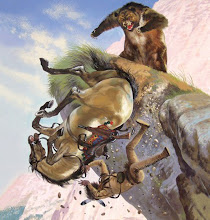
I was watching the Discovery channel the other night and saw a show that touched briefly on the whole debate centered around the age of the earth. Science's suggested older earth vs. the Bible's suggested (relatively) newer earth. And I certainly don't have the answer to that question. I know some folks get hung up with their belief when it comes to the age of the earth, evolution and other stuff like that, but for me, it just doesn't affect my daily life. Personally, I need Jesus because I am a sinner, not because I need some way to understand geology, biology, and the evolution habits of tiny fruit flies. I'm more interested in who made the earth and why.
However, one chain of logic that I hear often from the non-creation group that kind of irks me was featured in the show I was watching, and that's what I want to focus on here. I'm not blaming the show, you hear this explanation all the time. It goes something like this: When scientists discovered they could look at rocks and learn from their erosion and carbon dating processes they also learned that the rocks would have taken years to form their fjord or canyon-like shapes. They were roughly able to tell how long the rocks had been there. So the show claimed, as others do, that the Bible's description of a younger earth was totally proved wrong and the very idea that a creator was involved in making the earth began to be challenged more and more.
But that logic just doesn't work. The rock theory tells you how long it would take the rocks to form that way over time-- ON THEIR OWN. Creationism means there's a Creator involved, right? One that creates things. Makes them happen. Sure, it would take a stream or a river centuries to carve out a new Grand Canyon. But what if someone is causing it to happen? Forcing the river down into the dirt like an sculptor gouges his clay? Creationists assume there's another factor in the equation. God. You can't take that factor out in order to prove that it's not true. It's the very center of the Creationism argument.
I'm not saying therefore Creationism is right, I'm just saying that argument doesn't work for me.
Here's another way I sometimes look at it: God is the author of the world. Tolkien created Middle Earth in the 1930s. But it was created with a vast history of characters that spanned back for eons, ages and ages of folklore, and a well-lived in, ancient land. Why couldn't a creator create something new with a history that already exists? What if he wanted the rocks to look that way, so the best way to do it was to have them worn down for a long time, but since he's God and he can make an aardvark with wings if he wanted to, he could also skip the wearing down process. He could make new rocks that looked however he wanted them to look. A little far-fetched I know, and I don't think that's necessarily the way it happened, but how do I know? We live in a natural place that was supernaturally made, so the regular rules don't apply.
I'm not against science. And I understand why scientists often think they have to remove more intangible elements out of the equation. But one discipline alone is not enough to answer why and how we're here. And science is kind of strange in that it wants to exist on its own without religion or imagination, and gets mad if you like to mix it up with less touch-and-feel-based explorations.
I'm sure there are many levels to this age-old debate that I could never understand. But if you believe in a Creator, you might as well also believe he can create things. If you don't believe in one, then there's plenty of ways to judge the creation on its own and come away empty-handed.
Ironically, the show I was watching was called The Way the Earth was Made.

